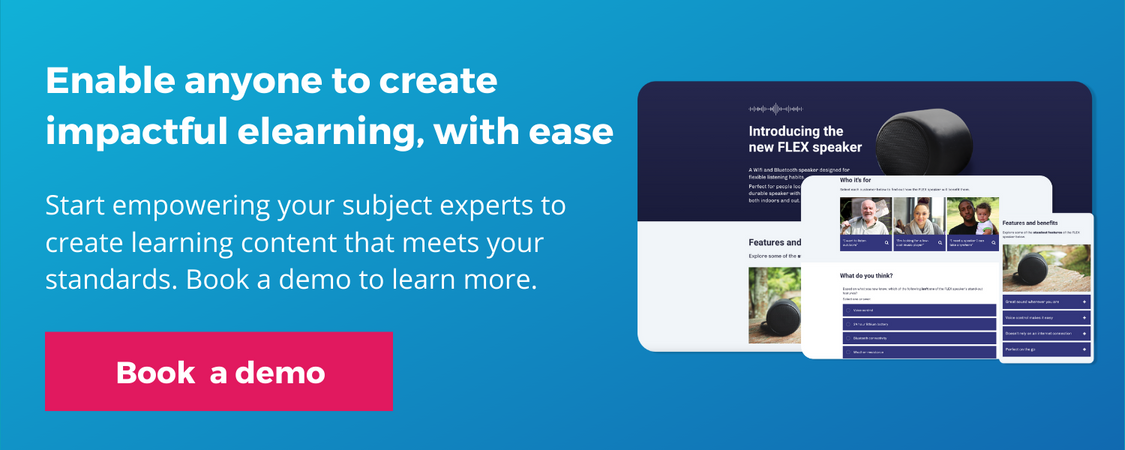Cohort-based courses: utilizing collaborative workplace learning
7 minute read
Once upon a time, massive open online courses (MOOCs) were the hottest ticket in the elearning sphere. Then came the rise of cohorts. The biggest flaws of the MOOC model was disjointed and disconnected learnings. The human touch wasn’t there, and collaboration was few and far between. Cohorts took all the benefits of MOOCs and added structure and teamwork. Research actually shows that cohort-based courses can yield better results in the modern workforce, suggesting the days of the MOOC may well be numbered. Here, we take a closer look at this method of learning, including its plus points, shortcomings, and how to adapt a cohort-based program to remote teams.

What is cohort-based learning?
Cohort-based learning is an approach that harnesses the power of collaboration and community to improve learning quality. With cohort-based elearning, a group of learners embark on a course together, sharing their experiences, perspective, and ideas to create a more dynamic learning environment.
Typically, learners are encouraged to work together toward a common goal. Every step of the way, from commencement to the finishing line, the group will be working together. This is a great way to create a sense of camaraderie and support that can have potent benefits as a motivator for learners.
Pros and cons of cohort-based learning
Cohort-based learning advantages
One of the key benefits of cohort learning is that it creates a structured and supportive environment which is conducive to learning. Rather than leaving learners to navigate material on their own, they’re given a ready-made community that can help them stay on track, ask questions, and provide feedback.
Another big advantage of cohort-based learning is the way it promotes continuous learning. It facilitates participation in collaborative activities such as group discussions or peer review sessions, as well as more informal chats. This type of engagement boosts focus and the ability to keep hold of information.
As well as being highly adaptable to different learning styles and preferences, cohort-based courses are equally flexible when it comes to time and location. Tailor-made for remote workforces, cohort-based elearning can connect colleagues from all over the globe, allowing them to share a learning experience without even needing to be on the same continent.
Cohort-based learning disadvantages
While cohort-based learning has many benefits, there’re also some potential disadvantages for L&D teams to be aware of.
It’s not a one-size-fits-all method and won’t be suited to all learners’ needs and schedules. As such, selecting groups carefully is important to ensure all learners have the same benefits from their experience. Getting this wrong can make a cohort-based program fall at the first hurdle.
Similarly, it can be difficult to ensure that all learners are progressing at the same pace. This can be particularly challenging if some learners are struggling with the material or have other commitments and conflicts that make it difficult to keep up with the rest of the group. Not only is this detrimental to the personal development of the learner in question, it can also create frustration for the rest of the cohort.
Another disadvantage of cohort-based learning is that it makes it near impossible to provide personalized learning. While it offers a supportive and collaborative environment, it may not be able to provide the one-on-one attention that some learners require to succeed.
Cohort-based courses are notoriously difficult to scale, given their hands-on approach and focus on smaller groups.
Cohort-based learning vs self-directed learning
Cohort-based learning is emerging as an alternative to self-directed learning for many in the elearning space. Naturally, there are distinct contrasts between self-paced online courses and cohort-based courses.
The self-paced approach allows learners significantly more freedom and flexibility to complete the course material at their own pace. This learning style may appeal to some employees who’d prefer to get their head down or have heavy workloads and schedule issues.
Cohort-based elearning, on the other hand, provides access to an instructor or facilitator, as well as a community of peers to offer support and accountability. As mentioned, this learning method allows all students to experience the course together in real-time.
The pacing of the curriculum differs between the two models. In self-paced courses, learners often have unlimited access to the course materials and can take as long as they need to complete the course.
Conversely, cohort-based courses have set deadlines for completing the course material that need to be adhered to. This difference can have a significant impact on success rates.
Finding the right method for you depends on the structure of the organization and the desired learning outcomes. Cohort elearning is great for encouraging cross-department collaboration and can be applied to global workforces, although a self-directed approach may be more suitable for those in different time zones to prevent any delay in the delivery.

How to design cohort-based courses for remote workforces
Designing a cohort-based course has some intricacies that self-paced courses don’t have to consider. While the learning outcomes remain the same, there’re factors like schedules, experience, and of course the dreaded Zoom fatigue to bear in mind.
Following these 7 steps will help you design a quality cohort-based course for remote teams.
1. Identify learning objectives and outcomes
Before you get your hands dirty designing and implementing a cohort-based course, it’s important to identify clear learning objectives and outcomes. Doing so ensures the learning materials align with the needs and goals of the cohort, as well as the wider business.
Your objectives are, in essence, milestones that will be hit during the course. Outcomes are the knowledge skills and behaviors gained by the end of it.
2. Create a structured curriculum
You need a structured pathway for your cohorts to head down. Designing a curriculum achieves this. To determine what to include in your program, you should first seek answers to key questions such as:
- Who is the intended audience for this course?
- How can I assist them in solving a problem or achieving a goal?
- Which portions of the curriculum should be self-paced and which should be completed as a group?
- How does my role as an educator or teacher factor into the lessons?
- What learning outcomes should employees derive from each lesson?
When developing a curriculum for a cohort-based course, it’s crucial to strike a balance between active and passive learning. Additionally, incorporating fun and interactive methods, such as gamification, can help students connect with the material and provide a break from learning new concepts.
3. Design the learning experience
With the curriculum in place, you’ll need to determine the structure of the learning experience to get the best results for your remote workforce. Consider the delivery method, the duration of the course, and the frequency and duration of the sessions.
You may consider methods such as microlearning and gamification here to ensure that the materials are engaging and fun, as well as fully collaborative.
4. Choose your cohort model
There’s more than one way to deploy cohort-led learning. Opting for a full cohort could be too demanding to your remote workforce, particularly when time restraints come into play. If this is the case, you may opt for hybrid cohort learning.
Also referred to as semi-synchronous collaborative learning, it’s essentially a mixture of self-paced and cohort learning. It can take the form of a combination of pre-recorded materials that can be accessed anytime and live remote sessions.
This can help overcome hurdles such as varying schedules and time zones while still reaping the rewards of the cohort-based model.
5. Equip yourself with the right tools
An elearning course is only as good as the tools that facilitate it. Ensure you have all the relevant software and communication tools to hand, as well as a robust learning management system that can be the home for the course itself. This is essential for maintaining consistency and monitoring progress.
You may also enlist the help of an authoring tool, such as Elucidat, to help design your learning materials.
6. Carefully choose your facilitators
Facilitators are as important to the process as an LMS or the materials themselves. They’ll be the sherpa that leads the cohort to the desired learning outcomes, nudging them back on track should they drift.
This is particularly crucial in remote workforces, as the likelihood of falling behind increases compared to office-based learning. Choose a highly organized facilitator with leadership experience.
7. Develop assessment and evaluation methods
Assessment and evaluation methods are essential to analyzing the effectiveness of the course and where improvements can be made in future. This can include everything from quizzes and exams to focus groups and surveys.
Ensure that the feedback mechanism is able to easily gather feedback from participants. Use this data to measure the effectiveness of the course and make changes accordingly.
Launch optimized cohort training with Elucidat
Elucidat provides a range of features to support cohort-based training, such as collaboration tools, social learning features, and the ability to track progress and engagement.
Try it out for yourself and book a demo today to see how Elucidat can help you unlock a world of cohort learning possibilities.




